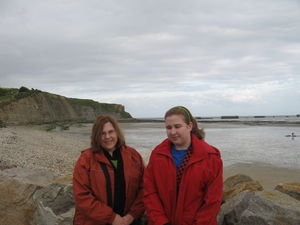Advertisement

 Arromaches
Arromaches
In the backround, remains of the artificial (Mulberry) harbours which were towed accross the English Channel.Today we visited 2 of the DDay beaches - Juno (Canadian) and Omaha (USA).
Here are some photos.
Operation Overlord - D-Day: June 6, 1944 : For 4 consecutive years, thousands of soldiers of all nationalities underwent intensive training in England. Although millions of tons of material were prepared, and hundreds of tanks, cars and trains were later dispatched for DDay, its exact date remained a mystery until the very last moment. More than a year earlier, with the help of the French Resistance, every detail of every possible plan had been scrutinized to test the feasibility of each mission on location. Three days before the launching of this huge wartime operation, more than 200,000 soldiers and marines embarked on about 5,000 ships.
The combination of moonlight, weather and tides was critical, so June 6th was chosen.
It was also good fortune that the German High Command utterly lacked any perception of what was to be, just a few days before the landing. Although the Germans knew that an Allied landing would occur very soon, they were convinced it would take place on the Pas-de-Calais beaches much further north of Normandy. Hitler was so astonished by the coincidental timing of all

 Juno Beach
Juno Beach
Guided tour at the Canadian Juno Beach Centre. The Centre is only 5 years old.these simultaneous officer departures with the landings, that he considered opening an investigation to assess if treason was behind it all. When the startled German officers and soldiers with a front row view from their beach bunkers saw thousands of ships emerging on the horizon, they immediately knew that this was certainly not just a diversion maneuver. But none of their messages were taken seriously and the "Fuhrer" was not even awakened.
As early as 1940, the BBC (Radio London) transmitted a daily series of coded messages to allow the Allies based in England to communicate with the Resistance in France, to ask them to plot various sabotages and, most importantly, to prepare for the upcoming landing in Normandy. A few days before D-Day, the commanding officers of the Resistance heard hundreds of messages, but only a few of them were really significant. When said twice, the first line of the poem by Verlaine, Chanson d'Automne, "Les sanglots longs des violons de l'automne" meant that the "day" was imminent, and when the second line "blesse mon coeur d'une langueur monotone" was also repeated, the Resistance knew that the invasion would take place within the next 48 hours. Messages such

 Juno Beach
Juno Beach
On top of a German bunker.as: "Il fait chaud à Suez" (It's hot in Suez), "Les dés sont sur le tapis" (The dice are on the mat), "Le chapeau de Napoléon est dans l'arène" (Napoleon's hat is in the arena), "John aime Marie" (John loves Marie), "La Guerre de Troie n'aura pas lieu" (The Trojan War will not take place) or "La Flèche ne passera pas" (the Arrow will not get through), all told the members of the Resistance it was time to go about their respective missions, which included destroying water towers or entire communication networks, or dynamiting selected roadways.
Advertisement
Tot: 0.094s; Tpl: 0.01s; cc: 8; qc: 43; dbt: 0.0472s; 1; m:domysql w:travelblog (10.17.0.13); sld: 1;
; mem: 1.1mb

 Arromaches
Arromaches
 Juno Beach
Juno Beach
 Juno Beach
Juno Beach


